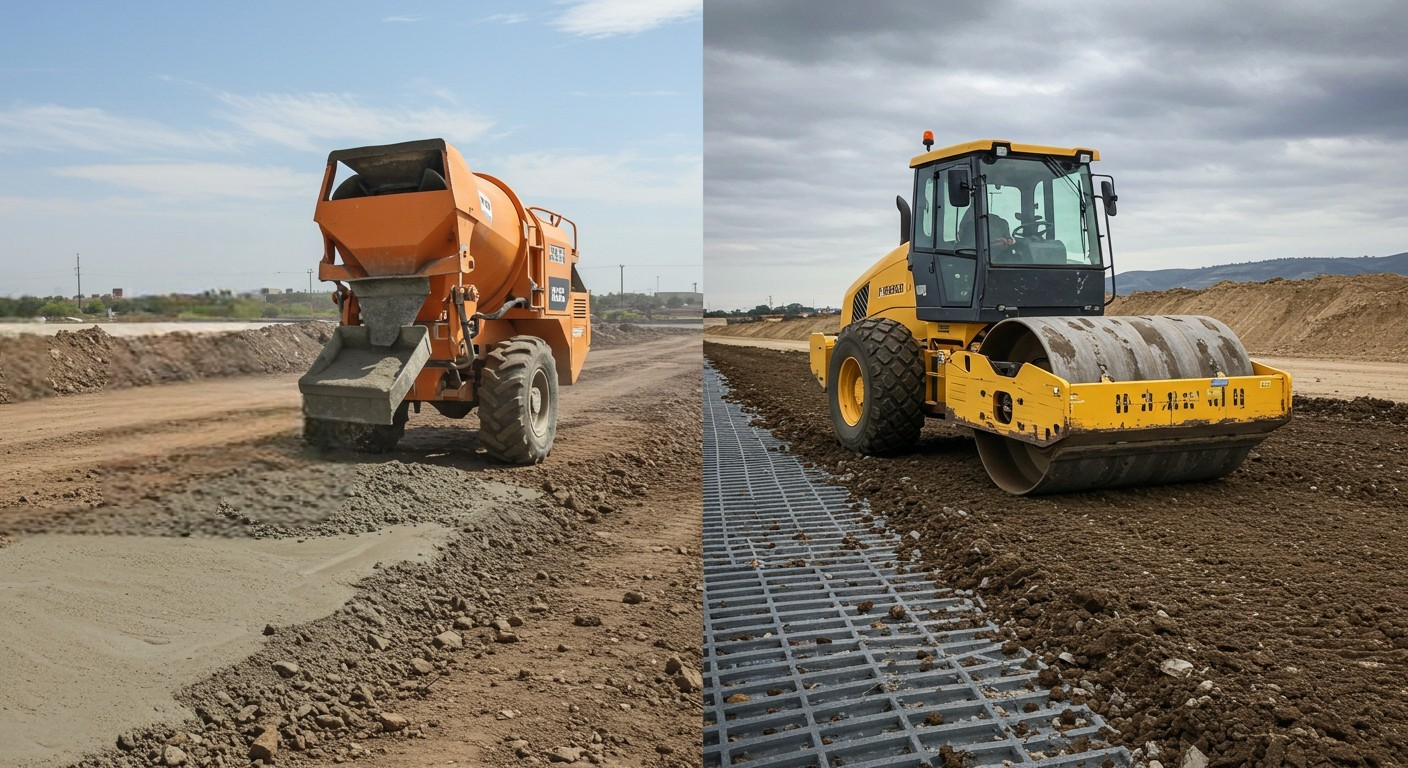At R-Factor Spray Foam, we’ve seen firsthand how foundational strength makes or breaks a structure literally. When clients ask us about chemical vs. mechanical ground stabilization, they’re not just curious. They want to know which method will hold up, keep their property secure, and give them peace of mind. We’re here to cut through the confusion and give a straight answer, based on what we’ve learned on the job, in the soil, and through solving real-world foundation issues across Florida.
Whether you’re a contractor weighing stabilization methods, a homeowner prepping for a major renovation, or a project manager overseeing large-scale infrastructure, the difference between chemical and mechanical stabilization isn’t just academic it’s what keeps your investment standing strong. By the end of this guide, you’ll know exactly what sets these two techniques apart, when to use each, and how our team at R-Factor Spray Foam helps clients make the right choice every time.
What Is Chemical Ground Stabilization, and When Does It Make Sense?
Chemical stabilization works by modifying the soil with additives usually lime, cement, fly ash, or other chemical agents that change its properties. The goal? To improve strength, reduce moisture content, and make the ground more uniform and predictable.
When we’re working with highly plastic clays or moisture-sensitive soils, chemical treatment allows us to lock in stability without excavation. This is especially useful in tight-access jobs, under existing foundations, or when environmental conditions limit the use of mechanical machinery.
Soil Behavior and Stabilization Results with Chemical Methods
We often recommend chemical stabilization when the soil has poor load-bearing capacity but can be treated in place. For instance, if we’re working with expansive clay, introducing lime can reduce swell potential significantly something mechanical compaction alone can’t fix. Our field crews have tackled countless jobs where we’ve turned unstable ground into a solid base within days, with minimal surface disruption.
How R-Factor Spray Foam Leverages Chemical Stabilization in the Field
We don’t just dump chemicals into the soil and hope for the best. Our team analyzes soil samples, calculates application rates precisely, and ensures deep penetration for consistent results. We’ve worked with builders, municipalities, and private landowners across Florida to reinforce everything from roadways to school buildings often saving time and excavation costs in the process.
What Is Mechanical Ground Stabilization, and Where Does It Outperform?
Mechanical stabilization relies on physical force compaction, reinforcement, or structural support elements to increase the ground’s load-bearing capacity. Think vibratory rollers, geogrids, and compacted gravel layers. It’s about reshaping the soil structure, not altering its chemical makeup.
When the soil type responds well to compaction like sandy or granular soils we often start here. This method is fast, scalable, and cost-efficient on wide-open job sites. And in many large-scale projects, it’s the go-to choice before pouring foundations, installing pavement, or setting retaining walls.
Application Areas Where Mechanical Stabilization Is Ideal
In projects where the soil is already well-drained or where site conditions allow for heavy machinery, mechanical methods offer excellent speed and repeatability. For example, we recently prepared a commercial lot for slab-on-grade construction in Pasco County using a geotextile fabric and gravel system layered with compaction a simple, reliable solution that delivered long-term performance.
The R-Factor Spray Foam Approach to Mechanical Stabilization
Our team evaluates load paths, soil gradation, and moisture content to determine whether mechanical methods alone will do the job or if a hybrid approach is needed. We own and operate compaction equipment that allows us to stay agile on the job site, ensuring quality control from the ground up. Clients rely on our input early in the process to avoid missteps and delays.
Comparing Long-Term Outcomes: Chemical vs. Mechanical
Both methods can provide lasting stability but only if matched properly to the soil and project scope. That’s where most DIY jobs or one-size-fits-all contractors fall short.
Chemical stabilization often wins in reactive soils, where mechanical compaction might cause surface crusting without real depth improvement. But mechanical stabilization excels in granular or sandy soils where structural reinforcement can be quickly achieved.
Maintenance and Performance Over Time
Chemical stabilization offers more moisture resistance, particularly in areas prone to seasonal shifts in groundwater. Once treated, these soils tend to hold their integrity better against the freeze-thaw cycle or extended rain periods. Mechanical systems, on the other hand, may require surface re-compaction or reinforcement over time especially if water infiltration becomes an issue.
Choosing Based on Florida Conditions and Project Goals
In Florida, we encounter high water tables, clay pockets, and sandy backfills all in one lot. Our clients rely on our experience to read these variables and apply the right method. In many cases, we use chemical stabilization for subgrade correction beneath roads or pads, while applying mechanical stabilization to control surface-level stress.
Making the Right Choice Starts with a Soil Assessment
The truth is, neither method is universally better. What matters is aligning the method with the soil profile and the structure being supported. That’s why we start every project with a soil test.
Once we understand soil bearing capacity, moisture levels, and plasticity, we tailor a solution that lasts. We’re not in the business of quick fixes we deliver results that stand the test of time.
How R-Factor Spray Foam Delivers Smarter Ground Stabilization
Our crews are trained in both chemical and mechanical methods, and we often combine the two. On large-scale developments, for instance, we might chemically treat soft clay areas and mechanically stabilize sandy zones. It’s this hybrid thinking that gives our clients confidence and long-term results.
We Solve Problems Others Miss
We’ve been called in to fix projects that failed due to mismatched stabilization methods. With our deep understanding of Florida’s soils and how to treat them, we help clients avoid expensive mistakes and deliver a finished product that stays level, strong, and reliable.
Your Groundwork Matters More Than You Think
Ground stabilization isn’t flashy. But it’s the foundation that holds everything else together. Whether you’re building a home, paving a parking lot, or developing commercial property, choosing the right stabilization method isn’t optional it’s mandatory.
And with R-Factor Spray Foam, you don’t have to guess. We bring proven strategies, real-world expertise, and a commitment to quality that shows in every inch of ground we treat.
Let’s Build a Stronger Foundation Together
You don’t have to gamble with ground stability. You need the right method, expert execution, and a team that backs it all with experience and honesty. That’s exactly what we deliver at R-Factor Spray Foam.
We’re not just here to install foam we’re here to solve real problems at their source. And whether that calls for chemical treatment, mechanical reinforcement, or both, we’ve got the tools, the team, and the know-how to make it happen.
Still Curious? Let’s Break Down More with R-Factor Spray Foam
- Which is more affordable: chemical or mechanical stabilization?
It depends on soil type, depth of treatment, and access. Mechanical is usually cheaper for large, open areas. Chemical works well where excavation is limited. We’ll help you calculate what makes sense. - Can both methods be used together?
Yes—and often should be. Hybrid stabilization allows us to treat problem zones chemically and reinforce others mechanically, maximizing performance and cost-efficiency. - How do I know which method is best for my site?
Start with a soil test. We provide full assessments and walk you through your options based on science, not guesswork. - How long does each method last?
Properly applied chemical stabilization can last decades with minimal maintenance. Mechanical methods may need touch-ups if subjected to repeated stress or water intrusion. - Will chemical treatment contaminate the soil or groundwater?
We use environmentally responsible materials and follow industry best practices to protect your site and the surrounding environment. - Is chemical stabilization safe around homes or gardens?
Absolutely. We use formulations that are safe when applied correctly, and we take extra precautions near homes and sensitive areas. - What if I have uneven settlement after mechanical stabilization?
We can re-compact or reinforce the area—or upgrade to chemical treatment if the soil profile calls for it. - Do I need permits for ground stabilization work?
Permits may be required depending on location and scope. We handle all the paperwork, inspections, and compliance steps. - How fast can the work be completed?
Mechanical methods are generally quicker. Chemical treatment can take longer depending on curing time and depth, but we’ll give you a clear timeline before starting. - Do you work with general contractors or directly with property owners?
Both. We collaborate with builders, engineers, and homeowners—whoever needs the job done right.


